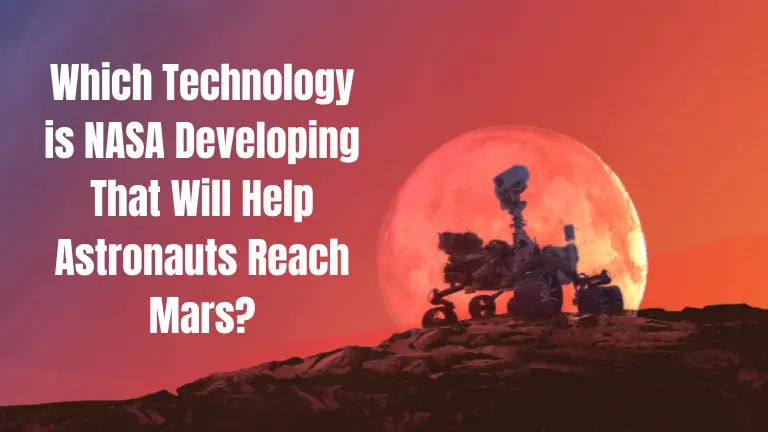In the quest to explore the vast expanse of our solar system, NASA has set its sights on Mars as the next frontier. The journey to the Red Planet poses numerous challenges, requiring groundbreaking technologies and innovative solutions.
In this article, we will delve into the technologies being developed by NASA that will enable astronauts to reach Mars and conduct successful missions.
Which Technology is NASA Developing That Will Help Astronauts Reach Mars?
Here are some reasons why NASA is developing technologies to help astronauts reach Mars:
The Challenges of Mars Exploration
Mars exploration presents a myriad of challenges. The long-duration journey, ranging from six to nine months, exposes astronauts to radiation, isolation, and microgravity effects. The need for life support systems, energy generation, and resource utilization further compounds the complexity of these missions.
NASA’s Current Technologies for Mars Missions
NASA has already made significant strides in developing technologies for Mars missions. The Mars rovers, such as Curiosity and Perseverance, have provided valuable insights into the planet’s geology, atmosphere, and potential for past habitability. The Mars Reconnaissance Orbiter and Mars Odyssey spacecraft have greatly enhanced our understanding of the planet’s surface and subsurface conditions.
Next-Generation Spacecraft and Propulsion Systems
To shorten travel times and increase payload capacity, NASA is developing next-generation spacecraft and propulsion systems. These advancements include the utilization of ion propulsion, nuclear propulsion, and innovative aerodynamic designs. These technologies aim to revolutionize interplanetary travel, making Mars missions more efficient and feasible.
In-Situ Resource Utilization (ISRU)
One of the key aspects of sustainable Mars missions is the utilization of local resources. ISRU involves extracting and utilizing resources found on Mars, such as water ice, to produce propellant, breathable air, and even construction materials. NASA is actively researching techniques to enable astronauts to live off the land and reduce their reliance on Earth for essential supplies.
Advanced Life Support Systems
For astronauts to survive long-duration missions to Mars, advanced life support systems are essential. These systems must provide a closed-loop environment capable of sustaining human life in space for extended periods. NASA is developing cutting-edge technologies to recycle air, water, and waste, ensuring a sustainable life support system that minimizes reliance on resupply from Earth.
Robotic Exploration and Precursor Missions
Robotic exploration plays a vital role in paving the way for human missions to Mars. NASA has been deploying robotic rovers and landers to gather data, conduct experiments, and assess potential landing sites. These precursor missions provide crucial information about the Martian environment, surface conditions, and resources, aiding in the planning and preparation of future crewed missions.
Habitat Design and Construction
Designing habitats suitable for the harsh Martian environment is a significant challenge. NASA is exploring innovative architectural concepts, materials, and construction techniques to create durable habitats that can withstand radiation, extreme temperatures, and dust storms. 3D printing technology is being utilized to construct habitats using locally available resources, reducing the need for transporting bulky construction materials from Earth.
Radiation Protection and Health Monitoring
Radiation exposure is a critical concern during Mars missions due to the lack of a protective magnetic field and the intensity of cosmic rays. NASA is developing advanced shielding materials and technologies to minimize radiation risks for astronauts. Additionally, comprehensive health monitoring systems are being developed to track astronauts’ vital signs, detect any health issues, and provide timely medical support during the mission.
Artificial Intelligence and Robotics
AI and robotics are becoming indispensable tools for astronauts on their journey to Mars. These technologies assist in various tasks, including autonomous navigation, maintenance, and scientific data analysis. NASA is incorporating AI algorithms and advanced robotic systems to enhance efficiency, safety, and productivity during space missions, enabling astronauts to focus on critical tasks while relying on intelligent robotic assistants.
Communication and Navigation Systems
Reliable communication and navigation systems are crucial for successful Mars missions. NASA is developing advanced communication technologies, including laser-based systems, to improve data transmission rates and reduce signal delay. Furthermore, precise navigation systems utilizing celestial references and advanced imaging techniques are being developed to ensure accurate trajectory calculations and landing procedures on Mars.
Sample Return Missions
In the pursuit of scientific discovery, NASA is planning sample return missions from Mars. These missions aim to collect samples of Martian rocks, soil, and potential signs of past life and bring them back to Earth for detailed analysis. The development of innovative sample retrieval systems and spacecraft capable of safely returning to Earth with valuable scientific specimens is a significant focus of NASA’s technology development efforts.
International Collaborations
The exploration of Mars is a global endeavor, and international collaborations play a pivotal role in advancing technologies for Mars missions. NASA collaborates with space agencies around the world, sharing knowledge, resources, and expertise. This collaboration fosters innovation, accelerates progress, and ensures that the challenges of Mars exploration are collectively addressed.
Future Prospects and Timeline
NASA’s technology development efforts for reaching Mars are steadily progressing, but significant milestones lie ahead. The agency has set ambitious goals to send humans to Mars in the 2030s. However, the exact timeline will depend on the successful development and integration of the various technologies discussed in this article. NASA remains committed to pushing the boundaries of space exploration and making human missions to Mars a reality.
Conclusion
In conclusion, NASA’s ongoing development of advanced technologies for Mars missions holds great promise for reaching the Red Planet. Stay updated and explore more tech articles with us. Keep visiting for exciting updates.
